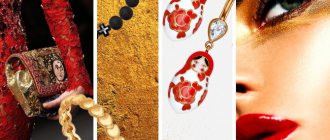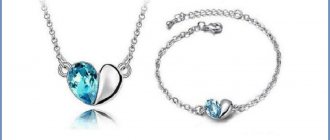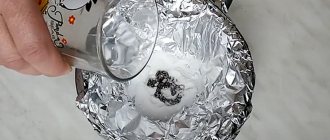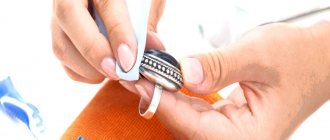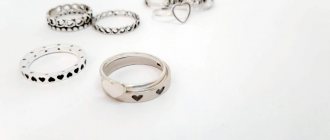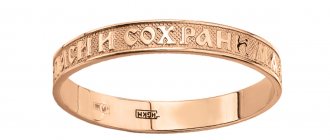Gold plated jewelry has always been popular. They look quite luxurious and elegant and at the same time are much cheaper than gold items. But, like any jewelry, gold-plated silver requires careful care.
If you notice that a dark coating has begun to appear on your favorite rings and chains, this is a sign that the jewelry needs to be cleaned. There are different methods for cleaning gold-plated silver, but not all of them are reliable or safe for your jewelry.
We are sharing with you proven ways to clean gold-plated silver at home quickly and safely.
Types and causes of contamination of gold-plated silver
Gold plating is the protection of silver with a thin layer of gold, in addition, the procedure gives the item an expensive and beautiful look. Gilding is used both in jewelry production and in the manufacture of various parts for medical equipment, in mechanical engineering, and in the creation of original decorative elements - candlesticks, cups, ashtrays and figurines.
In stores you can often see spoons, cake spatulas, souvenirs, cups and glasses made of 925 sterling silver and plated with gold. Such silver really looks very beautiful, but to clean it, you need special compounds and little tricks.
If you look at the quality of gold-plated silver, you will notice one feature - it begins to change color over time. At first, you can notice small spots, darkening, and then serious changes appear on the surface of the gold-plated silver. It’s not worth treating a thing with anything without knowing special methods or effective means.
After all, this is possible:
- damage the appearance of silver;
- break the gilded coating.
However, gold-plated silver is much stronger than ordinary gold or other metals, and with careful care it can last a long time without wearing out or losing its beauty.
In general, contamination of gold-plated silver can be divided into several types:
- surface dust, dirt;
- chemical - stains from detergents, contamination from cosmetics, perfumes;
- old pollution, darkening from environmental influences.
A common cause of contamination of gold-plated silver is careless use. Therefore, you should wear such jewelry with extreme caution and protect the gilding from the effects of household chemicals and cosmetics. I wouldn’t even risk washing a cup with detergent just once if I had a ring or bracelet made of silver with gold plated on my hand.
Despite the strength of gold-plated silver, its resistance to acids, and its resistance to environmental influences, it is susceptible to darkening or the formation of dark green stains on the surface.
To avoid this, it is recommended to store gold-plated jewelry in special boxes, and also periodically wipe gold-plated silver with a soft fiber cloth, removing dust and dirt.
The main enemy of such products is mechanical stress. Therefore, I do not recommend wearing gold-plated silver every day, subjecting it to friction and scratching. After all, over time, the gilding will be erased, and ugly spots will appear on the silver.
Another factor that affects the wear and tear of gold-plated jewelry is time. Even the highest quality item with such a coating eventually fades, turns black and loses its attractiveness.
To restore the thin layer on gold-plated silver, I advise you to contact a jeweler. Professional help is good if the item is expensive, particularly memorable, or of great value. I would go to a jeweler if the gold-plated item is large, inlaid with stones, with a special finish.
In all other cases, when it comes to simple pollution, I would use folk remedies. The main thing is to do everything strictly according to proven technology and be careful.
Baking soda
This simple product will help restore the beauty and shine of gold-plated jewelry and remove blackness. You should proceed like this:
- Pour 300 ml of water into a container and place on the stove;
- place jewelry in heated water;
- add 1 tsp. baking soda;
- boil;
- boil for 5 minutes;
- turn off the stove, cool the water and rinse the product.
Advice
You cannot rub gold plate with a sponge and soda - the dirt will be removed, but the item itself will be scratched.
What not to clean
Let me remind you that gold plating is a soft, delicate coating, so any abrasive products cannot be used. Do not use conventional jewelry or gold cleaning products on gold-plated silver.
They do not work if gold-plated silver items are dirty and can completely ruin them. Do not use sponges, hard brushes, or rough washcloths to clean gold-plated silver items.
Wine alcohol
This substance helps to quickly and effortlessly remove stains from a gold-plated item without spoiling it. How to proceed?
- Soak a sponge in alcohol.
- Rub the product until completely clean.
We recommend: According to research, cleaning is harmful to health, you should clean less often: what the facts say
Finally, you can also use a piece of suede, then the products will shine like new.
Methods for removing stains from gold plated
There are many folk remedies that allow you to remove stains, dirt and restore the shine and beauty of gilded silver.
But the first thing I recommend paying attention to is the nature of the stain and its duration. If you notice just dirt on your favorite gold-plated earrings, then you should work with them using a soft rag, wiping without pressure.
This is often enough to remove surface dirt and restore shine to cleaned silver. But if the darkening is old, then I recommend choosing stronger substances, but not aggressive household chemicals. I do not recommend using cleaning compounds on other surfaces.
Safe tools
To work with gold plating, I advise you to stock up on a soft toothbrush, paper towels, and natural scraps of soft fabric. Thin sticks, such as toothpicks, will come in handy to help clean narrow, hard-to-reach places.
Industrial chemistry
When selecting cleaning products for gold-plated items, I chose from those that were tested empirically.
For example, the Aladdin product cleaning solution is effective when working with gold-plated jewelry, as well as the HG product, designed specifically for gold-plated products. After treatment with this composition, the shine of the cleaned jewelry increases.
When purchasing pastes or liquids, I advise you to carefully study the list of components and purpose. The instructions should mention that the product will not harm gold-plated silver.
Folk remedies
Folk methods suggest using home techniques that have been used for centuries to clean gilding. The components of these recipes are found in every home; they do a good job of removing old stains on silver jewelry or decorative items.
Wine spirit
Effectively restores the shine of darkened gilding. I recommend following a simple rule - apply a little alcohol to a soft cloth and clean the silver without pressing. Then I would rub the silver with a suede rag to add shine. If there is no alcohol in the house, you can replace it with wine vinegar.
Cleaning with beer
Regular beer can restore a second life to a gold-plated item. To clean jewelry, I take, pour an alcoholic drink into a glass and place the gold-plated item there for half an hour.
Then I take out the product and blot it with a paper napkin. This is one of the quite effective methods; it can restore a new shine to even an antique item. Objects cleaned with beer look very impressive.
Soap solution
An ordinary bar of soap can help in cleaning your favorite gold-plated earrings:
- A piece of solid soap is grated.
- A teaspoon of the resulting shavings is diluted in warm water, the ideal temperature is 50...60 ° C.
- Place a gold-plated object in the solution and leave for 30–35 minutes.
- Then the item is taken out, washed well with water, and wiped dry with a soft cloth.
The resulting solution will give an even stronger effect if you add a couple of drops of ammonia to it.
Alcohol and turpentine
Alcohol for wiping gold-plated items is suitable both ethyl, denatured and medical. I do not recommend diluting turpentine for wiping darkened items. I use one of these products to combat old dirt and discoloration.
I apply the cleaning component directly to the sponge, then treat the product. The basic rule is to clean the product without pressing. After finishing the procedure, I wipe the silver with a soft cloth. This will give the thing the lost shine.
Running a cloth over your favorite ring or pendant one more time is the best way to prevent tarnishing.
By the way, ethyl alcohol is also suitable as a pre-cleaning agent. There are no greasy deposits left on products cleaned with alcohol; the product helps remove most surface contaminants.
Table vinegar
I recommend using ordinary vinegar as an ideal means for initially cleaning things from dirt.
For this procedure you will need:
- standard cup (glass);
- 15 minutes;
- two tablespoons of vinegar.
In order for the cleaned jewelry to regain its original shine, you need to wipe it with a soft-lint cloth after treating it with vinegar.
If you don’t have table vinegar at home, you can clean your earrings or ring with wine vinegar: moisten a piece of soft cloth and wipe the product. After this, the item is polished with a soft cloth made of natural or artificial suede.
Egg white
I noticed that some products can have a beneficial effect when cleaning gold-plated silver items. For example, a chicken egg, and both the egg white and the yolk are beneficial. I separate the protein and stir it, place the darkened decoration in it for 10-15 minutes. Then I rinse well, dry with a paper towel and wipe with a piece of flannel or wool.
Egg yolk and javel water
Egg yolk cleans gold well, but to make it even more effective, you need to add Javel water. It has whitening properties and allows you to clean even jewelry with old stains.
If there is no such water, then it is recommended to use “Whiteness”, adding it to the protein in the amount of 1 tbsp. spoons.
Use protective gloves when working with this mixture, and then rinse the cleaned products thoroughly with running water. An egg can be used to clean silver quickly and safely.
Baking soda
Every housewife will certainly have a small amount of soda in her kitchen. This component will not only help remove dirt deposits from the gilding, but will also clean the surface, giving it a shine, like a new product.
Try cleaning a gold-plated accessory with this product:
- 1 teaspoon of soda;
- 300 milliliters of water;
- ladle.
Pour water into a container, place the item, add soda. Then leave the product for 30 minutes. I rinse with water and dry.
Ammonia
I would recommend using ammonia together with a mild detergent. It will help clean even heavily soiled earrings or a gold-plated ring.
The proportion is simple:
- a handful of grated soap or a little mild dishwashing detergent;
- 6 drops of ammonia;
- 0.5 liters of warm water.
I mix all this and place the product in a container with the solution for 30–40 minutes. Then I rinse the silver under water and dry it on a towel.
Hydrogen peroxide
This pharmaceutical product can help remove stains and darkening from a gold-plated item in a few times. To clean a thing that has lost its marketable appearance, I prepare a solution consisting of 40 ml of peroxide, 2 tablespoons of ammonia and dishwashing detergent (or soap solution).
Mix all the ingredients and leave the gilded silver in the mixture for 20 minutes. Then I take out the silver, rinse it with water and dry it.
Sugar
I use this product not so much to remove heavy dirt from gold plates, but to add shine. I often use sugar after cleaning with vinegar and alcohol. Add 2 full tablespoons of sugar to a glass of water. Then I soak the already cleaned ring or chain in the resulting solution for 10 hours.
After this, I wash the gold-plated silver with water and dry it. Please note: when placing a gold-plated chain in the solution, the lock is left outside, otherwise the liquid will not clean it, but will seal it.
Toothpaste
Cleaning gold plate with toothpaste is quick and easy. To do this, you need to wet the accessory, then dip it in soda. It turns out that the surface of the silver is covered with adhering soda. Add a little toothpaste and work on the outside and inside. The main thing in this case is not to rub things too hard on the surface.
In our case, cleaning well means not damaging the product. I warned you! Then I wash the gold-plated silver with water and dry it on a towel. Cleaning silver with the paste is easy and simple.
Onion pulp
I grate the onion (grind it in a blender), and then put the product in the resulting pulp for half an hour. Then I make sure to rinse the silver and wipe it dry. The method is simple, but very effective against stains on gold plating. They can be cleaned quickly and efficiently.
Preliminary stage
First, rinse the product under the tap and wipe it with a soft cloth or cotton pad. Then do one of the following:
- Prepare a solution of 1 liter of water and 2 tbsp. l. table vinegar. Place the item in a container with this liquid for 15–20 minutes.
- Soak a cotton pad in rubbing alcohol and wipe the surface several times.
Note! If the product has just begun to fade, you can do without preliminary actions.
Rules for wearing, care and storage of gold-plated items
I recommend wearing gold plating on special occasions, as the coating makes items fragile and susceptible to mechanical stress. I would not recommend taking a shower in a product made of gold-plated silver, so as not to touch or damage it when drying with a towel.
Do not store jewelry in open spaces, in places not protected from dust and dirt. The risk that the silver will get dirty and will have to be cleaned soon is very high.
Sugar
A simple, effective and safe means of updating gold plated items at home.
- Add 3 tbsp to a glass of warm water. l. Sahara.
- Stir thoroughly.
- Place decorations in the glass.
- Leave for 4 hours.
- Remove items and rinse.
Advice
This method will not help get rid of stubborn dirt and heavy dirt, but it will perfectly renew the jewelry and return it to its original shine.
Prevention measures
To ensure that the problem of tarnished gold-plated silver no longer arises, you must follow certain rules for caring for such products:
- Do not store them in places where the temperature and humidity are both high, for example, in the bathroom. The impact of these two factors will immediately greatly reduce the service life of the product, which, at the same time, will begin to fade and darken much faster.
- All gold-plated jewelry must be stored separately, preferably wrapped in suede fabric. If we are talking about cutlery, they should be in a case that will also separate them from each other.
- After each use of jewelry, you should wipe it with a piece of suede to remove particles of grease and dirt. It is better to carry out such minimal cleaning regularly than to subsequently clean already darkened jewelry.
- Do not expose gold plates to direct sunlight, as this will cause them to fade and darken. Keep such items away from sharp objects that could scratch the surface.
History of the use of silver in various fields
For a long time, which dates back to 2.5 thousand years BC, historians were able to obtain irrefutable facts according to which, in Ancient Egypt, warriors with the help of silver plates applied to battle wounds were cured and saved from possible infection and death. In Rus', too, the healing and neutralizing power of silver objects was noticed quite a long time ago. So, in churches, holy water was poured and stored in silver vessels specially cast for this purpose. And the phenomenon associated with a silver spoon in a glass of water has been known to everyone since the days of studying at school from a life safety course.
It is thanks to its unique properties that silver began to appear in a huge number of objects surrounding humans. Ancient and modern scientists, inventors and jewelry makers try to cleanse the world around a person who owns one or another silver item. Gradually, silver could be found in almost all cutlery, dishes, mirrors, and, of course, jewelry. Elements of silver were added to fabrics, which made it possible to decorate even clothes and shoes.
What should not be used for cleaning?
The use of any abrasives is strictly prohibited. Even the softest ingredients (toothpaste, chalk) can seriously damage earrings and rings. Gilding can be very thin, so such products erase it.
You should not wash your jewelry with ingredients such as:
- Chalk (allowed to be used only in thoroughly crushed form).
- Soda.
- Powder.
- Toothpaste.
Re-gilding, or new life for old jewelry
Gilding inevitably wears off over time. How long you wear your jewelry depends on the quality of the precious coating, proper wearing and storage. If you buy a ring in a specialized store with a certificate of conformity, the product will delight you with the shine of gold for up to 2 years or more. Gold plating on pendants and earrings lasts much longer. No one can vouch for goods from a street stall. This gilding can come off in a week or turn black.
The age of gilding is short-lived, and it can be unbearably bitter to part with a beloved piece of jewelry. There is a way out! Today, specialists offer services for applying new gold plating. Using galvanic equipment and electrolytes, any metal or silver can be gilded in a matter of minutes. The price of restoration depends on the total area of the product: 1 cm² - from 3 rubles. For example, re-gilding a spiral bracelet will cost approximately 800 rubles. The price depends on the thickness of the precious layer (0.2-1 microns) and the purity of the sprayed metal. Experienced electroplating specialists admit that it is difficult to apply a coating thicker than 1 micron in this way.
The distressed jewelry is infused with 24 karat 999 pure gold. To achieve the desired shade, cobalt, nickel or copper can be added to gold. When electroplated, the gold layer has high adhesion (adhesion) to the substrate and is resistant to abrasion. After such a restoration, the old jewelry will sparkle in a new way.
To restore gilding, choose professionals in your field. Newly-minted galvanizers will not be able to do quality work. In this matter, you need to know many subtleties and strictly adhere to production technology.
Don't settle for cheap services. Consider carefully whether you need to reconstruct the old decoration or whether it is better to buy a new one. A rare piece of unique design worthy of restoration. You can safely retire an ordinary ring and buy a brand new fashionable ring.
We extract gold using electrolysis
For this method you will need:
- container made of heat-resistant glass or porcelain;
- 50 g of potassium cyanide;
- 1 liter of distilled water;
- iron or silver plates are used as a cathode.
Proceed as follows:
- Hang the cleaned gold-plated objects on the positive electrode (anode).
- Dip into the bath with the prepared solution.
- Turn on DC voltage between 12 and 15 V.
Important! At a voltage of 12-15 volts, gold will form a film on the cathode. At a higher level - in the form of a sponge.
Important! Good results can be obtained if you use concentrated sulfuric acid as an electrolyte and a lead plate for the cathode. The voltage should be 3-4 V.
Compared to the chemical method, the electrolytic method of removing gold plating is simpler and more effective, since it produces a larger amount of gold removed.
Salt
This method will not help get rid of stubborn stains, but will return the product's shine and lightly clean the metal.
- 200 ml of water is poured into the pan.
- Add 1 tsp. salt.
- The solution is placed on gas and heated.
- Products are immersed in it, brought to a boil and boiled for 15 minutes.
After this, jewelry and cutlery should be rinsed and polished with suede.
